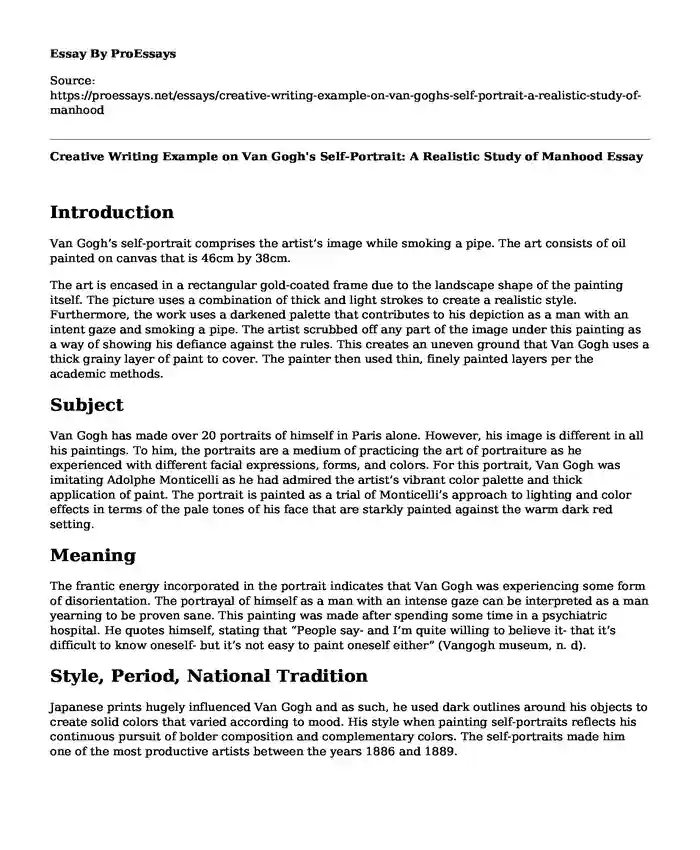Introduction
Van Gogh’s self-portrait comprises the artist’s image while smoking a pipe. The art consists of oil painted on canvas that is 46cm by 38cm.
The art is encased in a rectangular gold-coated frame due to the landscape shape of the painting itself. The picture uses a combination of thick and light strokes to create a realistic style. Furthermore, the work uses a darkened palette that contributes to his depiction as a man with an intent gaze and smoking a pipe. The artist scrubbed off any part of the image under this painting as a way of showing his defiance against the rules. This creates an uneven ground that Van Gogh uses a thick grainy layer of paint to cover. The painter then used thin, finely painted layers per the academic methods.
Subject
Van Gogh has made over 20 portraits of himself in Paris alone. However, his image is different in all his paintings. To him, the portraits are a medium of practicing the art of portraiture as he experienced with different facial expressions, forms, and colors. For this portrait, Van Gogh was imitating Adolphe Monticelli as he had admired the artist’s vibrant color palette and thick application of paint. The portrait is painted as a trial of Monticelli’s approach to lighting and color effects in terms of the pale tones of his face that are starkly painted against the warm dark red setting.
Meaning
The frantic energy incorporated in the portrait indicates that Van Gogh was experiencing some form of disorientation. The portrayal of himself as a man with an intense gaze can be interpreted as a man yearning to be proven sane. This painting was made after spending some time in a psychiatric hospital. He quotes himself, stating that “People say- and I’m quite willing to believe it- that it’s difficult to know oneself- but it’s not easy to paint oneself either” (Vangogh museum, n. d).
Style, Period, National Tradition
Japanese prints hugely influenced Van Gogh and as such, he used dark outlines around his objects to create solid colors that varied according to mood. His style when painting self-portraits reflects his continuous pursuit of bolder composition and complementary colors. The self-portraits made him one of the most productive artists between the years 1886 and 1889.
The Artist
Vincent Van Gogh can be identified as a unique artist who painted with a sense of urgency that often resulted in immense stress. His fame was created from his bold brushwork, as evidenced in this portrait, as it clearly illustrates his emotions.
The Context
From a historical point of view, this painting can be identified as a source of painting styles in regards to palette and brushwork. From a social point of view, this painting can be defined as a heartfelt artistic cry of anguish from his mental suffering. From a philosophical point of view, the portrait can be used to determine the artist’s need to discover himself amidst the chaos in his head. From a religious point of view, Van Gogh puts his faith in this portrait by hoping that other artists who view his painting will be inspired to rise and take up their positions in the world of art.
Conclusion
To conclude, it was enjoyable to do the Van Gogh Museum virtual tour. The tour was a significant art event as it featured the artwork of Vincent Van Gogh, who was a famous painter who painted numerous self-portraits as well as paintings of other features such as workers, peasants, and townspeople. The paintings in the museum depict Van Gogh’s subjects expressively, colorfully and truthfully to create a truly captivating event. What attracted me most to the Self-portrait with pipe painting was the artist’s intense gaze in the portrait, which made me want to understand the emotion behind the picture.
Works Cited
Van Gogh Museum. "Van Gogh Museum Groundfloor, Amsterdam, Netherlands — Google arts & culture." Google Arts & Culture. N.p., n.d. Web.
<https://artsandculture.google.com/streetview/van-gogh-museum-groundfloor/2QHwyv_Y6gueAw?hl=en&%3Bsv_lng=4.8808198&%3Bsv_lat=52.3585336&%3Bsv_h=-19.92648221949179&%3Bsv_p=-14.958125813166376&%3Bsv_pid=T4EwMNbRYOhcEPF8T1I8xw&%3Bsv_z=0.9999999999999997&sv_lng=4.8814297&sv_lat=52.358326&sv_h=133.2942599754251&sv_p=-25.159581710736646&sv_pid=VeZQB2bwxABfxAqGNzUlUQ&sv_z=2.5316372389054775>
Cite this page
Creative Writing Example on Van Gogh's Self-Portrait: A Realistic Study of Manhood. (2023, Oct 10). Retrieved from https://proessays.net/essays/creative-writing-example-on-van-goghs-self-portrait-a-realistic-study-of-manhood
If you are the original author of this essay and no longer wish to have it published on the ProEssays website, please click below to request its removal:
- The Power of Story - Social Media in My Life
- Paper Example on Vitruvius Model
- Cinematic Invisibility in Brokeback Mountain Essay
- Social Media Enhances the Public Sphere Essay
- Civil Architecture and Lessons Derived for Technological Architecture Paper Example
- The African Americans Many River to Cross Episode 2 Essay Example
- Creating Solutions: Architect's Challenges in Construction Projects - Essay Sample







